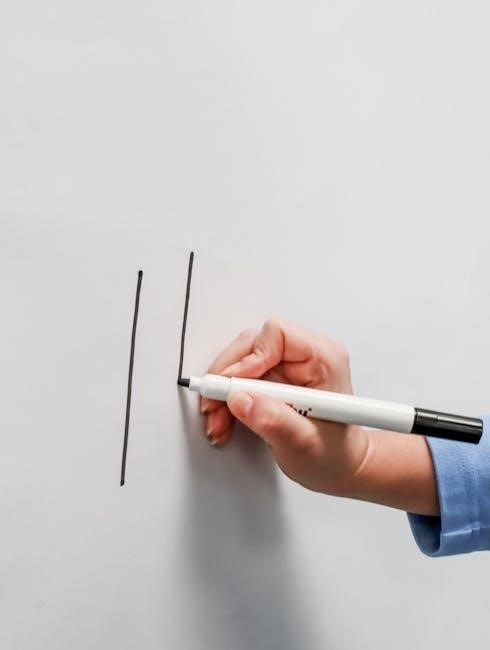
Brother LS-590 Instruction Manual: A Comprehensive Guide
This guide serves as your key to unlocking the full potential of your Brother LS-590 sewing machine. It provides clear, concise instructions, eliminating confusion and frustration. Find information about the machine, maintenance, and how to download the manual in PDF format.
Understanding the Manual’s Purpose
The Brother LS-590 instruction manual is your essential companion for mastering this versatile sewing machine. This document is designed to guide both novice and experienced sewers through every aspect of the machine’s operation. It will help you understand its features, from basic threading to more advanced techniques like using the one-step auto-size buttonhole.
The primary purpose of this manual is to provide clear and concise instructions, eliminating any confusion or frustration. You’ll find detailed diagrams and step-by-step explanations that make learning easy. Whether you’re setting up the machine for the first time, troubleshooting a problem, or exploring new sewing techniques, this manual is your go-to resource.
Furthermore, this guide offers insights into maintenance, ensuring your machine remains in optimal condition for years to come. It covers everything from bobbin winding to stitch selection, empowering you to fully utilize the LS-590’s capabilities. By understanding the manual’s purpose, you’ll be well-equipped to confidently tackle any sewing project.
Identifying the Main Parts of the Sewing Machine
Familiarizing yourself with the main components of your Brother LS-590 is the first step towards confident sewing. This section will guide you through identifying each part and understanding its function.
Let’s start with the bobbin winder, crucial for preparing the lower thread. Next, locate the spool pin, which securely holds the thread spool. Pay attention to the various thread guides that ensure smooth and consistent threading. Understanding the stitch selector dial is vital for choosing the right stitch for your project.
The LS-590 boasts a one-step auto-size buttonhole feature; identifying its components is key to effortless buttonholes. Additionally, the machine features a jam-resistant drop-in top bobbin system, simplifying bobbin changes. Don’t forget to note the built-in storage compartment for keeping accessories organized.
By knowing these essential parts, you’ll be able to navigate the machine’s functions with ease. Refer to the manual’s diagrams for a visual guide, making the learning process even more straightforward.
Bobbin Winder Functionality
The bobbin winder is an essential component of your Brother LS-590, responsible for preparing the bobbin with the lower thread needed for sewing. Understanding its functionality is crucial for smooth and efficient operation. This section will guide you through the process.
To begin, place an empty bobbin onto the bobbin winder spindle. Secure the thread from your spool, guiding it through the designated thread guides to ensure even winding. Engage the bobbin winder mechanism, typically a lever or switch, which activates the winding process.
The machine will automatically wind the thread onto the bobbin until it reaches the appropriate level. Once full, the bobbin winder will disengage, stopping the winding process. Carefully remove the filled bobbin from the spindle, trimming any excess thread.
Ensure the bobbin is wound evenly to prevent issues during sewing. Refer to the manual for specific diagrams and instructions related to your LS-590 model. Proper bobbin winding contributes significantly to the quality and consistency of your stitches. Practice makes perfect, so don’t hesitate to experiment to master this important step.
Spool Pin Usage

The spool pin on your Brother LS-590 is a seemingly simple, yet incredibly vital component. Its primary function is to securely hold the spool of thread, allowing it to unwind smoothly and consistently as the machine operates. Proper spool pin usage is essential for preventing thread snags, breaks, and uneven stitches.
Your LS-590 may have either a vertical or horizontal spool pin. Regardless of the orientation, always ensure the spool is placed correctly, with the thread unwinding freely. A spool cap, often included, should be used to secure the spool on the pin, preventing it from slipping off during operation.
When using larger spools, a larger spool cap might be necessary for optimal stability. The thread should then be guided from the spool, through the thread guides, and towards the tension discs; Refer to your manual for the specific threading path recommended for your LS-590 model.
Incorrect spool pin usage can lead to a variety of sewing problems. Therefore, taking the time to properly load the spool and guide the thread is a worthwhile investment in achieving professional-looking results. Always check the manual for detailed diagrams.
Thread Guide Instructions
Navigating the thread guides on your Brother LS-590 is crucial for achieving consistent and even stitches. These small, often overlooked components play a vital role in directing the thread from the spool to the needle, maintaining proper tension, and preventing tangles. Incorrect threading can lead to skipped stitches, thread breakage, and uneven seams.
Consult your LS-590 instruction manual for a precise diagram of the threading path. Typically, the thread will pass through several guides, starting from the spool pin, moving towards the tension discs, and then down to the needle. Each guide ensures the thread is correctly aligned and tensioned.
Pay close attention to the order in which the thread passes through these guides. Some guides may require you to loop the thread around them in a specific direction. This is essential for maintaining the correct tension. Always double-check your threading against the manual’s diagrams before beginning to sew.
If you experience issues with thread tension or skipped stitches, re-threading the machine, paying particular attention to the thread guides, is often the first and simplest solution. Clean thread guides regularly to remove lint or debris.
Stitch Selector Dial Operation
The stitch selector dial on your Brother LS-590 is your gateway to a variety of stitching options, allowing you to tailor your sewing to different fabrics and projects. Understanding how to operate this dial correctly is fundamental to achieving the desired results. The dial typically displays a range of stitch patterns, each represented by a symbol or number.
Before making any adjustments, ensure the needle is in the up position to prevent damage to the machine. To select a stitch, simply rotate the dial until the desired stitch pattern aligns with the indicator mark on the machine. The LS-590 features an easy-to-use stitch selector dial.
Refer to your instruction manual for a detailed explanation of each stitch pattern and its recommended applications. Some stitches are ideal for straight seams, while others are better suited for zigzagging, buttonholes, or decorative purposes. Always test your chosen stitch on a scrap piece of fabric before sewing your main project.
When changing stitch patterns, avoid forcing the dial. If it feels stuck, double-check that the needle is in the up position and that there is no obstruction. With practice, you will become familiar with the different stitch options and how to select them quickly and accurately.
One-Step Auto-Size Buttonhole Feature

The Brother LS-590’s one-step auto-size buttonhole feature simplifies the process of creating perfectly sized buttonholes. This feature eliminates the need for manual measurements and adjustments, ensuring consistent and professional-looking results every time. To use this feature, you’ll need the buttonhole foot, which is included with the machine.
First, attach the buttonhole foot to your sewing machine. Then, place the button you intend to use in the designated slot on the foot. The machine will automatically measure the button and create a buttonhole that is the perfect size. Select the buttonhole stitch setting on the stitch selector dial.
Position your fabric under the foot, aligning the starting point of the buttonhole with the indicator mark. Lower the foot and start sewing. The machine will automatically sew the entire buttonhole, including the bartacks at each end, and then stop.
Carefully remove the fabric and use a seam ripper to open the buttonhole. Be cautious not to cut the stitches at the ends. With a little practice, you will be able to create flawless buttonholes quickly and easily. Refer to your instruction manual for detailed diagrams and troubleshooting tips.
Jam Resistant Drop-in Top Bobbin System
The Brother LS-590 features a jam-resistant, drop-in top bobbin system, designed for ease of use and smooth sewing. Unlike traditional bobbin systems, the drop-in design allows you to quickly and easily insert the bobbin from the top of the machine. This eliminates the need to remove the accessory tray or struggle with awkward bobbin placement.

The jam-resistant design minimizes the likelihood of thread snags and jams, ensuring consistent stitch quality. To load the bobbin, simply drop it into the bobbin case, following the directional arrows. The clear bobbin cover allows you to monitor the thread supply, so you will know when it is time to replace the bobbin.
When replacing the bobbin, make sure the thread is properly threaded through the tension spring. This ensures that the thread tension is correct. If you experience any issues with the bobbin, consult your instruction manual for troubleshooting tips. The drop-in top bobbin system is a great feature for beginners and experienced sewers alike.
It saves time, reduces frustration, and contributes to a more enjoyable sewing experience. Proper bobbin loading and maintenance are essential for optimal performance.
Built-in Storage Compartment

The Brother LS-590 sewing machine includes a convenient built-in storage compartment to keep your essential sewing accessories organized and within easy reach. This integrated storage solution eliminates the need for separate containers or cluttered work surfaces, allowing you to focus on your creative projects.
The compartment is typically located on the front or side of the machine and is designed to hold items such as bobbins, needles, presser feet, screwdrivers, seam rippers, and other small tools. By keeping these items readily accessible, you can streamline your sewing process and avoid interruptions caused by searching for misplaced accessories.
To access the storage compartment, simply open the designated cover or drawer. The size and configuration of the compartment may vary, but it is generally designed to accommodate a variety of sewing essentials. Regularly check the contents of the storage compartment and remove any unnecessary items to maintain organization and prevent clutter.
The built-in storage compartment is a valuable feature that enhances the user-friendliness of the Brother LS-590 sewing machine. It promotes a tidy and efficient sewing environment, allowing you to maximize your productivity and enjoy your sewing projects to the fullest.
Troubleshooting Common Issues
Even with proper use and maintenance, you may encounter some common issues while using your Brother LS-590 sewing machine. This section provides troubleshooting tips to help you resolve these problems efficiently. Before attempting any repairs, ensure the machine is turned off and unplugged from the power outlet.
One common issue is thread breakage. This can be caused by incorrect threading, using the wrong type of thread for the fabric, or a damaged needle. Re-thread the machine carefully, ensuring the thread passes through all the guides and tension discs correctly. Replace the needle with a new one that is appropriate for the fabric you are using.
Another issue is skipped stitches. This can be caused by a bent or damaged needle, incorrect needle size, or improper fabric stabilization. Replace the needle and ensure it is the correct size for the fabric. Use a stabilizer, such as interfacing or stabilizer spray, to prevent the fabric from shifting during sewing.
If the fabric is not feeding properly, check the feed dogs to ensure they are raised and free of lint or debris. Adjust the presser foot pressure if necessary. If the bobbin thread is not winding correctly, check the bobbin winder mechanism for any obstructions; Refer to the manual for detailed instructions on bobbin winding.
Finding and Downloading the Manual in PDF Format
Accessing the Brother LS-590 instruction manual in PDF format is a convenient way to have it readily available on your computer, tablet, or smartphone. This allows you to consult the manual whenever and wherever you need it, without having to rely on a physical copy. There are several avenues you can explore to locate and download the PDF version of the manual.
The first place to check is the official Brother website. Navigate to the “Support” or “Downloads” section and search for the LS-590 model. You should find a downloadable PDF version of the instruction manual. Be sure to select the correct language if multiple options are available.
If the manual is not available on the Brother website, try searching online using a search engine like Google or DuckDuckGo. Use keywords such as “Brother LS-590 instruction manual PDF” to narrow your search. Several websites may host the manual for free download. However, exercise caution when downloading files from unknown sources, as they may contain malware.
Another option is to check online sewing machine communities or forums. Members may have uploaded the manual or be able to provide a link to a reputable source. Once you have located the PDF file, simply click the download button to save it to your device.